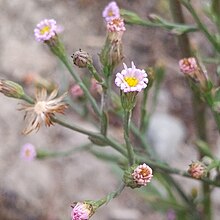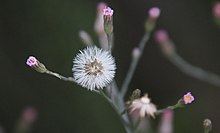| Symphyotrichum parviflorum | |
|---|---|

| |
| S. parviflorum growing at Coyote Hills Regional Park in Alameda County, California | |
| Scientific classification | |
| Kingdom: | Plantae |
| Clade: | Tracheophytes |
| Clade: | Angiosperms |
| Clade: | Eudicots |
| Clade: | Asterids |
| Order: | Asterales |
| Family: | Asteraceae |
| Tribe: | Astereae |
| Subtribe: | Symphyotrichinae |
| Genus: | Symphyotrichum |
| Subgenus: | Symphyotrichum subg. Astropolium |
| Species: | S. parviflorum
|
| Binomial name | |
| Symphyotrichum parviflorum | |

| |
| Native distribution[1] | |
| Synonyms[1][3] | |
|
Basionym
Alphabetical list
| |
Symphyotrichum parviflorum (formerly Symphyotrichum subulatum var. parviflorum) is an annual and herbaceous plant commonly known as southwestern annual saltmarsh aster.[4] It is native to Mexico, the Caribbean, most of Central America, Ecuador, and the southwestern United States. It is also known by the scientific name Symphyotrichum expansum.
